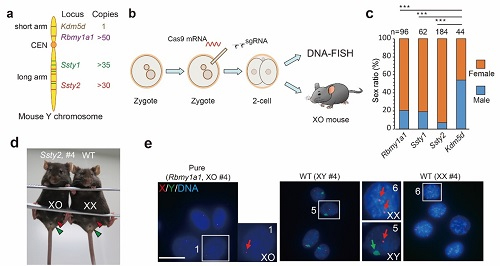Time:2019-12-13
Type II bacterial CRISPR/Cas9 system has been engineered into an efficient genome editing tool consisting of the Cas9 nuclease and a single guide RNA (sgRNA), dramatically transforming our ability to edit the genomes of diverse organisms. The sgRNA targets Cas9 to genomic regions to induce double-stranded DNA breaks, which are repaired by nonhomologous end-joining or homology-directed repair. CRISPR/Cas9 – mediate genome editing has been applied to generate cells or animals carrying precise gene mutations, rearrangement and deletion of chromosome segments.The researchersasked whether this powerful technology could be used for targeted chromosome elimination to generate animal models with chromosome deletion in various species and to treat human aneuploidy diseases involving chromosome addition.
To test this idea, the researchersfirst demonstrated thatY chromosome could be efficiently eliminated in mouse ES cells using CRISPR/Cas9-mediated multiple DNA cleavages at Y chromosome.These cleavages were induced by a single sgRNA or two sgRNAs that targeted multiple chromosome-specific sites, or by a cocktail of 14 sgRNAs, with each targeting one specific site.In addition, they showed that mouse X chromosome, human chromosome 7 and 14 could also be selectively eliminated by in cultured cells or embryos.More importantly, this approach eliminated human chromosome 21 in human induced pluripotent stem cells (iPSCs) with trisomy 21. This is the first report on X and autosome chromosome elimination via genome editing. It paves the way for studying aneuploidy in tumorigenesis and a potential genetic approach to chromosome therapy in vivo.
This work entitled “CRISPR/Cas9 - mediated targeted chromosome elimination” was published online in Genome Biology on Nov 25, 2017. ZUO Erwei, HUO Xiaona, YAO Xuan, HU Xinde, SUN Yidi, and YIN Jianhang are the first authors with equal contribution. This work was supported by National Science and Technology Major Project (2017YFC1001302), CAS Strategic Priority Research Program (XDB02050007, XDA01010409), the MoST863 Program (2015AA020307), NSFC grants (31522037, 31771485), Break through project of Chinese Academy of Sciences.

Generation of mouse model with Turner syndrome by CRISPR/Cas9-mediated Y chromosome elimination.a Schema of targeted gene loci in Y chromosome. b Experimental design. Cas9 mRNA and two specific sgRNAs that targeted Rmby1a1, Ssty1, Ssty2 or Kdm5d locus were injected into individual mouse zygotes.cSex ratio of mice generated by gene editing.dTwelve-week old XO mouse showing normal female genitals (green arrowheads) and nipples (red arrowheads). eRepresentative DNA-FISH images of cultured tail fibroblasts derived from XO mice.
 附件下载:
附件下载: